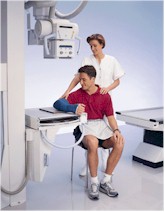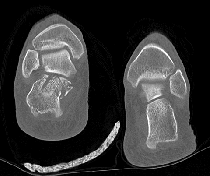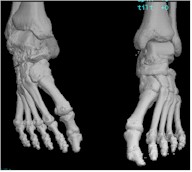Diagnostic imaging and orthopedic magnetic resonance (MR) imaging in particular play a crucial role in the sports medicine. Many injured joints are first examined with x-ray imaging. Most professional sports stadiums and arenas have clinics and training rooms which are now equipped with x-ray systems. X-ray is the imaging method of choice to diagnose broken bones and other fracture. If x-ray images of a painful joint do not reveal a fracture, the patient may be referred for MR imaging (MRI).

Technologist positioning athlete for an x-ray of the elbow
Computed Tomography (CT or CAT Scan) imaging is also finding increased use in diagnosing sports and orthopedic injuries and traumatic fracture. While CT is not as good as MR for imaging the soft tissue joint structures such as ligaments, tendons and muscle, CT is excellent for creating high resolution images of bones in cross sectional orientation (see image below). CT is also useful for creating three dimensional (3D) images of bones. 3D CT may be useful following trauma or fracture to show the orthopedist the orientation of small pieces or fractures bone. 3D CT can also show if a small piece of fractured bone has slipped into a joint space and is causing pain.
 |
 |
| Axial CT image of the
ankles showing fracture; note the small pieces of fractured bone on the left |
3-D CT image of both
ankles and feet showing a fracture on the left |
Updated: November 2, 2007



